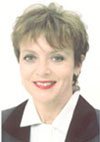News
Who's Who: Elisabeth Scherer
Seeing a need for interactive market research and having a passion for touchscreen technology, Elisabeth Scherer formed Diatouch two years ago.
August 12, 2003
Elisabeth Scherer, president of start-up market research-software maker Diatouch, is not one to give up a dream.
Scherer has always had an interest in consumer research and marketing. She knew there had to be a great way to reach consumers in an interactive way. And everything came together when she took a trip to the Smithsonian Institute in Washington, D.C., almost 20 years ago and saw touchscreens for the very first time.
"I was just fascinated with being able to get information on the Smithsonian exhibits. No one else used touchscreens like that. There were none in Europe that I had seen," said Scherer, a native of Austria who was living in Switzerland. "The thought of being able to bring information to consumers like that never left me."
 |
Elisabeth Scherer |
Scherer was conducting marketing for the pharmaceutical industry at the time, and saw the potential for using interactive technology to let patients educate themselves at their own pace.
Elisabeth found herself in Phoenix, Ariz., five years ago when her physicist husband, Jakob, was transferred to the United States by his employer in the semiconductor industry. She was still looking for opportunities to use touch technology.
Two years ago, she decided that she would form her own company and that marketing research would be her killer app. She formed Diatouch ("dia" stands for digitized interactive applications).
Diatouch produces software called Digivey that organizations can use in standalone kiosks with touchscreens to survey their customers. The company offers a complete package of hardware and software. Diatouch can build some kiosk enclosures, but mostly works with enclosure vendors such as CeroView and SeePoint Technologies. Diatouch uses 15-inch touchscreens from Elo TouchSystems. Scherer said the whole package with hardware and software generally runs about $3,500.
"We like to stay in a range under $10,000," she said. "An outdoor kiosk, though, might run as high as $20,000, considering environmental factors." She said such a kiosk would be perfect for surveying tourists at the Grand Canyon.
Diatouch markets the kiosks to museums, libraries and event organizers.
"I looked at companies that have a pressing need for market research; museums, libraries, retail, trade show organizers," said Scherer. "Healthcare is another area. That industry needs to survey its customers to meet quality-control standards."
The Tucson Children's Museum gave Diatouch a three-month trial in January, when it unveiled a traveling photography exhibit. Kiosks in the museum survey adults and children about their likes and dislikes. The surveys take about 90 seconds.
Diatouch will also be prominent at the Arizona Hospitality Expo in October at Phoenix Civic Plaza. The show will have four kiosks on the floor, surveying visitors about the expo.
Elisabeth Scherer Hometown: Zug, Switzerland, now resides in Phoenix, Ariz. Family: Husband/partner, Jakob; daughters Alexandra, 20; Evelyn, 17 Education: Bachelor's of business administration, Zurich and Berne Universities Hobby: Four horses that prevent her from ever leaving Phoenix |
Starting from scratch
When starting Diatouch, Scherer realized there was no market research software that she liked. She asked Jakob to develop the software. "There was nothing on the market that could do what I envisioned," she said. That included integrating multimedia, such as text mixed with graphics and photography, and offering several different languages for users on the touchscreen.
Picture are important, Scherer said, because they prompt users. In the case of a museum survey, for instance, a visitor may not remember a particular exhibit by name and thus would not be able to answer questions about it. But if there was a picture of the exhibit along with the text, the visitor would probably remember the experience.
The choice of languages was a natural concern for Scherer, who hails from a country that speaks four languages. She also adopted the concerns of her new U.S. hometown. "I noticed that English is the second language of so many people in the Southwest. They might not be able to understand a question written in English," she said.
Jakob worked on the software in his free time, and eventually made Diatouch his full-time career alongside his wife. The Diatouch software is Windows compatible.
"There aren't enough clients requesting Unix or Linux just yet. When they do, we will work on that," said Scherer.
Scherer makes everything sound so easy. And she truly believes that it can be. "With technology, anything is possible."










